Showing Spotlights 49 - 56 of 217 in category All (newest first):
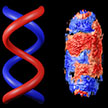 Researchers have developed a novel technique to quantify the helical morphology of gold chiral nanorods. Such nanoparticles exhibit unique properties in a sense that they can change the circular polarization of light. In many cases, these properties are believed to be caused by the helical (or 'screw-like') morphology of the nanoparticles, but until now it was very difficult to objectively analyze their shape. This methodology is the first building block towards a fundamental understanding of the chiroptical activity of nanoparticles.
Researchers have developed a novel technique to quantify the helical morphology of gold chiral nanorods. Such nanoparticles exhibit unique properties in a sense that they can change the circular polarization of light. In many cases, these properties are believed to be caused by the helical (or 'screw-like') morphology of the nanoparticles, but until now it was very difficult to objectively analyze their shape. This methodology is the first building block towards a fundamental understanding of the chiroptical activity of nanoparticles.
Mar 10th, 2022
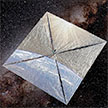 Adapting the concept of interstellar laser sailing for Earth orbital maneuvering and solar system exploration, researchers propose that the fundamental advantages of laser propulsion are manifested at much smaller laser powers in applications where conventional electric and chemical rockets are traditionally utilized. This approach makes use of low-power lasers, which are available already today, and novel light sail nanomaterials. These lasers push small, cell phone sized probes to velocities and destinations that are beyond the reach of current technologies, such as ever bigger chemical rockets being built or state-of-the-art ion engines.
Adapting the concept of interstellar laser sailing for Earth orbital maneuvering and solar system exploration, researchers propose that the fundamental advantages of laser propulsion are manifested at much smaller laser powers in applications where conventional electric and chemical rockets are traditionally utilized. This approach makes use of low-power lasers, which are available already today, and novel light sail nanomaterials. These lasers push small, cell phone sized probes to velocities and destinations that are beyond the reach of current technologies, such as ever bigger chemical rockets being built or state-of-the-art ion engines.
Feb 2nd, 2022
 This article discusses the use of nanotechnology in lubricants. Nanoparticle additives show significant enhancements in lubricant attributes like anti-oxidation capability, tribological features, and thermal properties. Nanotechnology offers the possibility of using nanosized additives to increase the performance of lubricating oil. The addition of nanoparticles to conventional base oils is a promising method for improving properties like friction and wear resistance in instruments.
This article discusses the use of nanotechnology in lubricants. Nanoparticle additives show significant enhancements in lubricant attributes like anti-oxidation capability, tribological features, and thermal properties. Nanotechnology offers the possibility of using nanosized additives to increase the performance of lubricating oil. The addition of nanoparticles to conventional base oils is a promising method for improving properties like friction and wear resistance in instruments.
Jan 26th, 2022
 Being a relatively young field, Bionanotechnology is often neglected within undergraduate and postgraduate curriculum. With an increasing number of researchers and professionals of different backgrounds coming into the field, there is a clear need to have learning platforms that cover techniques, strategies and methods that characterise the design of bionano structures. In September 2021, Cambridge Advance Online, a new educational initiative created between the University of Cambridge and Cambridge University Press and Assessment, launched a 6-week online course about Bionanotechnology: Bionanotechnology from Theory to Practice.
Being a relatively young field, Bionanotechnology is often neglected within undergraduate and postgraduate curriculum. With an increasing number of researchers and professionals of different backgrounds coming into the field, there is a clear need to have learning platforms that cover techniques, strategies and methods that characterise the design of bionano structures. In September 2021, Cambridge Advance Online, a new educational initiative created between the University of Cambridge and Cambridge University Press and Assessment, launched a 6-week online course about Bionanotechnology: Bionanotechnology from Theory to Practice.
Jan 11th, 2022
 The development of smart cities is linked to the development of new materials and devices, the use of sensor networks, the handling of huge amounts of data, the development of communication networks between objects, decision-making, and a range of other smart technologies. Many of these areas benefit from nanotechnology enabled materials and devices such as sensors, photovoltaics, efficient lighting systems or communication networks.
The development of smart cities is linked to the development of new materials and devices, the use of sensor networks, the handling of huge amounts of data, the development of communication networks between objects, decision-making, and a range of other smart technologies. Many of these areas benefit from nanotechnology enabled materials and devices such as sensors, photovoltaics, efficient lighting systems or communication networks.
Nov 30th, 2021
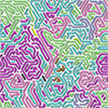 The modification of surface properties, such as metals, medical devices, and glass mirrors, represents a vital opportunity to inhibit the buildup of proteins or contaminants (i.e., fouling) for biomedical materials/devices, food packaging, many membrane filtration applications. Surface coatings with sustainable anti-fouling, bactericidal or the killing of bacterial membrane cells, and self-cleaning surface properties are particularly desirable and are receiving great attentions. Polymer-based coatings involving fabrications of nanostructured surfaces over conventional chemical-based antimicrobial agents have become major research efforts designed to greatly prevent protein/bacteria adsorption as well as to promote self-cleaning surface abilities for numerous industry applications.
The modification of surface properties, such as metals, medical devices, and glass mirrors, represents a vital opportunity to inhibit the buildup of proteins or contaminants (i.e., fouling) for biomedical materials/devices, food packaging, many membrane filtration applications. Surface coatings with sustainable anti-fouling, bactericidal or the killing of bacterial membrane cells, and self-cleaning surface properties are particularly desirable and are receiving great attentions. Polymer-based coatings involving fabrications of nanostructured surfaces over conventional chemical-based antimicrobial agents have become major research efforts designed to greatly prevent protein/bacteria adsorption as well as to promote self-cleaning surface abilities for numerous industry applications.
Jun 23rd, 2021
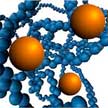 Various additives are added to plastics to either improve processability, change product properties or protect them against thermal, UV or light influences. In the case of a polymer nanocomposite, the additives have at least one dimension of less than 100 nm and can be found in the form of platelets, fibres or particles. They primarily serve to improve tensile strength, thermoformability, flame retardancy, optical and electrical properties, and the barrier properties of the plastic into which they are incorporated.
Various additives are added to plastics to either improve processability, change product properties or protect them against thermal, UV or light influences. In the case of a polymer nanocomposite, the additives have at least one dimension of less than 100 nm and can be found in the form of platelets, fibres or particles. They primarily serve to improve tensile strength, thermoformability, flame retardancy, optical and electrical properties, and the barrier properties of the plastic into which they are incorporated.
Mar 10th, 2021
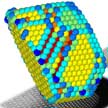 Gold nanoparticles are of great importance for a wide range of industrial processes such as CO oxidation, water-gas shift reactions and oxygen reduction at the cathode of hydrogen fuel cells. Scientists investigated the three-dimensional atomic structure of gold nanoparticles at high temperatures. By combining two powerful techniques, electron tomography with atom counting, researchers tracked the morphology changes in gold nanoparticles when heated.
Gold nanoparticles are of great importance for a wide range of industrial processes such as CO oxidation, water-gas shift reactions and oxygen reduction at the cathode of hydrogen fuel cells. Scientists investigated the three-dimensional atomic structure of gold nanoparticles at high temperatures. By combining two powerful techniques, electron tomography with atom counting, researchers tracked the morphology changes in gold nanoparticles when heated.
Jan 22nd, 2021
 Researchers have developed a novel technique to quantify the helical morphology of gold chiral nanorods. Such nanoparticles exhibit unique properties in a sense that they can change the circular polarization of light. In many cases, these properties are believed to be caused by the helical (or 'screw-like') morphology of the nanoparticles, but until now it was very difficult to objectively analyze their shape. This methodology is the first building block towards a fundamental understanding of the chiroptical activity of nanoparticles.
Researchers have developed a novel technique to quantify the helical morphology of gold chiral nanorods. Such nanoparticles exhibit unique properties in a sense that they can change the circular polarization of light. In many cases, these properties are believed to be caused by the helical (or 'screw-like') morphology of the nanoparticles, but until now it was very difficult to objectively analyze their shape. This methodology is the first building block towards a fundamental understanding of the chiroptical activity of nanoparticles.
 Subscribe to our Nanotechnology Spotlight feed
Subscribe to our Nanotechnology Spotlight feed





